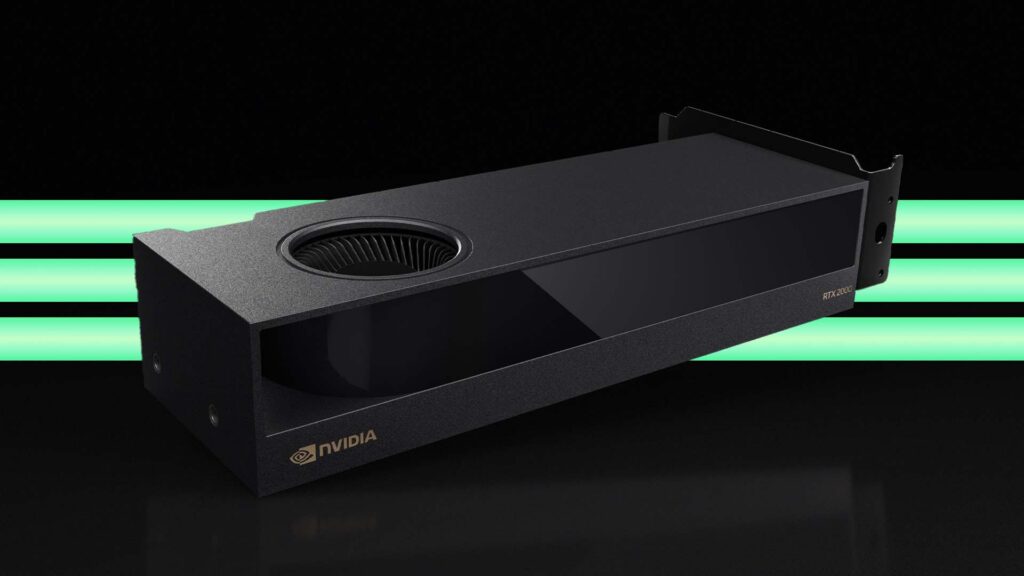Nvidia has added the Nvidia RTX 2000 Ada Generation (16 GB) to its family of workstation GPUs based on the Ada Lovelace architecture.
The $625 add-in board launched today at Dassault Systèmes 3D Experience World in Dallas, Texas – a significant location given that product designers and engineers are a key target audience.
The Nvidia RTX 2000 Ada Generation is a low-profile dual slot board, designed to fit in small form factor and ultra-compact workstations like the HP Z2 SFF / Mini and Lenovo ThinkStation P3 Ultra. It comes with both a half-height and full-height ATX bracket, so it can be used in full sized towers as well.
The Nvidia RTX 2000 Ada Generation comprises 2,816 CUDA cores delivering 12 TFLOPs of peak single-precision performance, 88 Tensor (AI) cores delivering 192 TFLOPs of peak performance and 22 RT (ray tracing) cores delivering 28 TFLOPs of peak performance.
The Nvidia RTX 2000 Ada Generation (16 GB) will replace the Ampere-based Nvidia RTX A2000 (12GB) (read our review) and provide a much more price competitive option than the $1,250 Nvidia RTX 4000 SFF Ada Generation (20 GB), which launched last year (read our review).
The Nvidia RTX 2000 Ada Generation looks identical to both GPUs and shares many of the same characteristics – four mini DisplayPort 1.4a connectors and a 70W max board power (so it doesn’t need an external 6-pin connector). However, unlike the Nvidia RTX 4000 SFF Ada, it does not support Nvidia Quadro Sync II or 3D stereo.
Target workflows for the Nvidia RTX 2000 Ada Generation include 3D CAD, BIM (Solidworks, Siemens NX, Revit, etc) and, in particular, design-centric visualisation and VR. Compared to the Nvidia RTX A2000, Nvidia reports superior performance in rendering (1.5 times better in KeyShot, 1.5 times better in V-Ray and 1.18 times better Solidworks Visualize) and in VR (1.4 times better in Enscape and 1.3 times better in KeyShot).
Nvidia also highlights much bigger rendering performance gains over 2019’s Nvidia Quadro P2200, a card that many users will likely be making an upgrade from. The Nvidia RTX 2000 Ada Generation is up to four times faster in Solidworks Visualize. This big leap is probably because the 5 GB GPU does not have dedicated ray tracing cores, but possibly because it’s under-resourced in terms of memory.
As the race for AI continues, Nvidia is also keen to highlight the Nvidia RTX 2000 Ada Generation’s AI credentials. According to Nvidia, the GPU doubles the AI throughput compared to the previous generation, thanks to fourth Gen Tensor cores. With text to image software Stable Diffusion, which can be used for architectural concept design, Nvidia reports 1.6 times better performance compared to the Nvidia RTX A2000.
Nvidia says a lot of work has been done ensure that all of its RTX Ada Generation GPUs are able to run AI inferencing on the desktop but admits that the RTX 2000 Ada won’t be a ‘powerhouse for AI training’.
The Nvidia RTX 2000 Ada is available now through the channel, and will be available from Dell, HP and Lenovo starting in April.
What DEVELOP3D thinks
The Nvidia RTX 2000 Ada Generation is an important release for Nvidia as it hits the price/performance sweet spot for architects, engineers and product designers who want to take their design workflows beyond CAD/BIM and into the realms of visualisation.
Prior to the launch, users had to pay a significant premium to get a low-profile Ada Generation board (Nvidia RTX 4000 SFF Ada), or go for the older Nvidia RTX A2000, which has less memory and does not support DLSS 3.0 which can make a big difference to real time performance in tools such as D5 Render, Chaos Vantage, Autodesk VRED and Nvidia Omniverse.
But what about the low end of the pro GPU market? For now, CAD users must still rely on the Nvidia T400 or T1000, which lack the dedicated Tensor cores for AI or RT cores for ray tracing. As CAD applications start to introduce ray tracing into the viewport and, especially as AI becomes more important, we would not be surprised if Nvidia introduces entry-level Ada Generation RTX cards soon.






